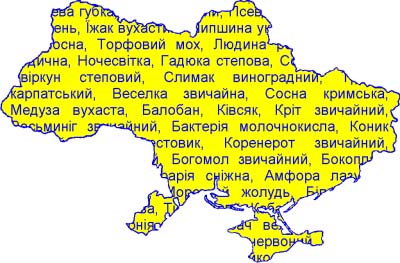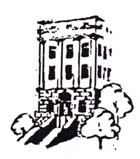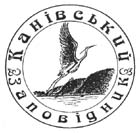

Welcome to the home page of Ukraine's First National Conference on Conservation and Biodiversity, held in Kaniv from 21-24 October 1997. The conference was well attended, with over eighty participants. This website makes accessible the scientific opinions and results presented and discussed at that Conference. The contributions are varied, and provide an invaluable snapshot of the current lively debate in Ukraine between scientists, policy-makers, administrators and others on how to conserve the country's substantial natural resources in the post-Soviet period, and how to ameliorate some of the ecological disasters it suffered in that time.
This Conference had its origins in a visit to Ukraine supported by the International Mycological Institute and the National Academy of Sciences of Ukraine in 1991 to establish contact between the two Institutes. As a result of that visit a Memorandum of Understanding was drawn up to establish a formal relationship and to foster collaboration amongst staff.
During that time, with growing interest in biodiversity, the idea of preparing a checklist of Ukrainian fungi arose. That proposal became a reality through the generosity of the UK Darwin Initiative which funded a collaborative project, Fungi of Ukraine, through which the Mycological Department of the M.G. Kholodny Institute of Botany was computerized and a large volume was produced.
Through the enthusiasm and hard work of the "Kiev Darwin Team" under the joint direction of Dr D.W. Minter and Prof. I.O. Dudka, and through the further generosity of the British Council, British Airways, PSINet and mFusion, we now see the realization of Ukraine's first National Conference on Conservation and Biodiversity, with its accompanying web-site.
The scope of the Conference and this resulting publication has exceeded all our expectations, and behind it, as a foundation, an enormous computerized database of Ukrainian fungi and plants has been built up. "Biodiversity", the extent of biological variation on Earth, has come to the fore as a key issue in science and politics for the 1990s. It is therefore a particular pleasure for us to commend the present book as a significant insight into the present state of our knowledge of biodiversity in Ukraine, and of the resources available to tackle the country's urgent nature conservation problems.
Ukraine is a country long famous for its love of the natural world, a love reflected in one of the world's richest and most diverse folk traditions. At the end of this century, Ukraine is justly proud of the beauty and cleanliness of much of its scenery. At the same time, however, the country is internationally notorious for pollution, particularly after the Chernobyl catastrophe. Ukraine's people, not just its scientists and politicians, seem to feel their country stands at an ecological crossroad, and their response is a renewed enthusiasm to protect nature in their beautiful land. This makes the present an exciting time indeed for conservation and biodiversity in this country. Our Conference seeks to catch that spirit. We have tried to gather as many as possible of those scientists who are actively thinking and working with these topics in Ukraine, and we want to stimulate debate on what needs to be done, and on how to go about doing it.
Even the briefest examination of this Conference website reveals the extraordinary breadth of interest in conservation and biodiversity to be found among these scientists. What makes this conference very special, however, is the clear awareness that biodiversity means more than just flowers, birds and larger mammals, and that conservation means more than strictly protected nature reserves. Of course there are contributions dealing with the larger animals - everyone recognizes their importance - but there is also, significantly, thought-provoking work on the insects, the fungi (lichenized and non-lichenized), the molluscs, the bacteria, the nematode and trematode worms, the algae, the non-flowering plants, and even viruses. Similarly, there are contributions dealing with the country's great national and international reserves; but these are matched by other contributions asking what value marginal land might have in nature conservation, what can be done for lakes and rivers, and how can land polluted by the old smokestack and mining industries be cleaned and re-used. Other papers review the philosophy of biodiversity, or look critically at techniques to monitor the devastation caused by pollution, or describe databases and other computerized systems which provide tools to carry out that monitoring. Yet further papers describe experiments in re-introduction of organisms to areas from which they had earlier been lost. The result will surely be an exciting debate.
In this introduction we formulate the main question of our Conference: "how should we organize ourselves to conserve our natural heritage and protect its diversity?" We believe the answer is this: what we need most of all is a strong non-governmental organization desirous of working with the government wherever possible, but sufficiently independent to be able, if necessary, to tell the government with one voice when it's wrong. To be effective, that organization - we could call it a national society for nature conservation - needs to have many characteristics. Let us list some of them.
There must be a nation-wide membership, open to all for a reasonable subscription. The society's job will be to promote information and education on conservation issues, to provide a focus for public fund-raising, and to encourage volunteer participation in conservation and monitoring schemes: the society should therefore also be the natural centre to which any member of the public interested in the natural world gravitates. In Britain, the number of members of the Royal Society for Protection of Birds recently exceeded one million for the first time. Imagine the influence of a conservation society which represents the views of a million Ukrainian voters.
Publicity is needed to get its message over within and outside Ukraine. A glossy magazine with text not only in Ukrainian but also in good idiomatic English is essential. A site on the world-wide-web would be a good idea. Then there are posters, greetings cards, t-shirts, souvenirs, calenders, diaries and all the other things which draw attention to the work of the society, and which also generate further revenue. Then the society needs certain key members. These are people whose names are known to all - celebrities, entertainers, radio and television personalities, people with influence who can attract a larger membership, who have the contacts to ensure the message gets into the media, and who have the skills in representing the society effectively when it does.
There must be a cadre of people within the society's executive with skills to raise money. They must be able to run high-profile public campaigns to raise money for the purchase of, for example, new nature reserves, and they must be able to approach international donor agencies and national and local bodies in both the public and private sectors, to top up the funds raised by those public subscriptions. For that group to operate successfully, an intelligence-gathering operation is needed with a database of potential donors, because these donors certainly exist: the present meeting is funded through the generosity of the British Council, and many other agencies, such as the UK Know How Fund, the UK Darwin Initiative, the Global Environmental Facility and the International Bank for Reconstruction and Development are out there waiting to be approached. Good quality information is needed, however, so that when a letter requesting assistance goes out, it reaches the correct person, and the right buttons are pressed to get the money.
The society needs a scientific arm. Part of this should be a forum where scientific issues can be regularly debated, and scientific policy formed. That forum would also have the job of scrutinizing governmental decisions to make sure they are based on the best information available. But there must also be a body to gather, curate and provide impartial scientific information on the status of different living organisms in the country - a national recording centre with well-structured computerized databases to handle monitoring information effectively.
Finally, the society also needs to carry out a lot of practical work. Its aim should be to own reserves itself and manage them in a way which sets an example for state owned reserves, nationally and locally. But the society should also work with those state reserves, perhaps by helping to channel international assistance to them reserves. It should also be a strong voice assisting the state in formulating more modern reserve management plans. At present, a policy of "strict protection" (i.e. doing nothing and permitting no access) is widespread in Ukrainian reserve management, but this may not always produce the results desired. A recent conference on steppe grassland management, in Kamiani Mohyly, for example, found that the zero grazing policy of "strict protection" is actually resulting in the gradual loss of these rare treasures of unspoiled steppe to scrub.
In Ukraine, at the moment, there are various bodies with the potential to form one or more parts of this society. The various learned scientific associations may have a role as a forum for scientific discussion, though they are on the whole desperately poor and still perhaps rather closely connected with the state. Some public societies like the one for bird-watchers are starting to emerge, and to eyes from outside Ukraine they sometimes seem more vigorous. Through the generosity of the UK Darwin Initiative and in collaboration with CABI, the M.G. Kholodny Institute of Botany has a biodiversity unit with good computers, sophisticated databases already holding vast numbers of records, and a team able to use the resource. Could that unit be the nucleus for a future national recording centre?
Finally, various broad-spectrum non-governmental conservation bodies have begun to appear in Ukraine, with the ability to produce informative and high-quality colour magazines and other publicity. Some are more vociferous and more politically inclined, like Greenpeace and the Green Party. Others are less so, but may be no less effective in their own way, like Zelena Ukraina and the Ukrainian Centre for Conservation. Should we, as scientists, sit on the sidelines and wait to see which emerges in front, or should we take an active part, and decide how we think things should go? We believe it is the job of this Conference to consider this great question, to debate the issues, to evaluate the arguments, and to make those decisions and recommendations which will shape the future character of biodiversity research and nature conservation in Ukraine.
Acknowledgements
It is with great pleasure that the Editors of this website and the Organizing Committee of the Conference and its associated Workshop record their warm thanks to the British Council for making the present project possible. The staff at the Kiev Office of the British Council and, in particular, Simon Williams, are thanked for their help and encouragement. The Conference has also received generous assistance from British Airways, PSINet and mFusion. Academician K.M. Sytnik, then Director of the M.G. Kholodny Institute of Botany, and Prof. D.L. Hawksworth, then Director of the International Mycological Institute have encouraged us at all points and, through them we have enjoyed the support of the National Academy of Sciences of Ukraine and CAB INTERNATIONAL. The Embassies of Ukraine in London and of the UK in Kiev kindly waived the charges for all visas issued for team members during the work of this project, and they are thanked for this help. It is appropriate also to remember with thanks the catalytic support of the UK Darwin Initiative which brought the present team together in the first place. Mr T.J. Minter provided considerable computing expertise which was particularly welcome during the final type-setting phase of the work, and in setting up the Conference web-site. The support of the families of all members of the team is warmly acknowledged and last, but certainly not least, we are grateful to all participants for the enthusiasm and interest they have given to this Conference and Workshop.
Organizing Committee
 |
 |
 |





| Previous page
Biodiversity Website: home page | Author: D.W. Minter |